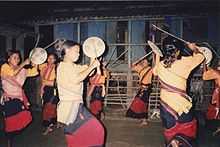Rabha tribe

Rabha (Assamese: ৰাভা) (Bengali: রাভা) (also Rava) is a little-known Scheduled Tribe community of West Bengal and Assam. The language/dialect spoken by the Rabha people is also of the same name. In West Bengal, Rabha people mainly live in Jalpaiguri district and Cooch Behar district. Moreover, almost, 70 per cent of them live in Jalpaiguri district. In Assam, the Rabhas live mostly in Goalpara and Kamrup districts. The whole area of Eastern and Western Dooars, may be termed as the cradle land of the Rabhas. The Rabhas refer to themselves as Koch and assert a connection to the historical Koch Kingdom.
Ethnicity and language
The Rabhas belong to the Indo Mongoloid group of people and have similarities with other members of Bodo group such as Garos, Kachari, Mech, Koch, Hajong and others.[1] Most of the Rabhas of Dooars refer to themselves as Rabha, but some of them often declare themselves as Kocha.[2] According to Dr. Francis Buchanan-Hamilton, the aspects of socio-religious and material life of the Rabhas have similarities with those of the Pani-Koch. E. Dalton on the other hand, argues that the Rabhas and the Hajongs are the branches of Kachari race and connected with the Garo.[3] According to B.H. Hodgson the Rabhas belong to the Great Bodo or Mech ft Pani-Koch and the Rabhas have the same lineage and the latter has their connection with the Garo.[4] A. Playfair (1909) also has pointed out some linguistic and cultural similarities between the Rabhas and the Garos. He also remarks that there exists a striking linguistic affinity between the A'Tong language and the Rangdania (Rabha) dialects. This led him to think that, at some point of time they lived in contact with each other.[5]
The Rabhas of West Bengal and Assam generally speak the local Bengali and Assamese dialects. The Rabhas who live in the forest villages have retained their original Rabha dialect to a great extent. The Rabha dialect, as stated by George Abraham Grierson, belongs to Bodo group of languages of Assam-Burmese branch.[6]
Economy and society
The traditional economy of the Rabhas in general, is based on agriculture, forest based activities and weaving. In the past, the Rabhas used to practice shifting cultivation. They continued to cultivate the land with Gogo or bill-hook. Later they took up the job of settled cultivation and started cultivation with plough. Besides cultivation, hunting was also an old practice of Rabha people. Weaving was a traditional occupation of the Rabha women.
Rabhas, who once used to live in the forest and practice shifting cultivation, were deprived of their rights to the forest by the colonial rulers, since the formation of forest department, banning on shifting cultivation and demarcation of forest boundaries. Consequently, with the colonial land settlement system, most of the displaced Rabhas either adopted settled cultivation as sharecroppers or took refuge in the forest villages as plantation laborers. After independence, Indian Government more or less continued the same colonial system of forest management, where the communities like Rabhas could not regain their rights to the forest. Today, one finds Rabhas in diverse occupations from forest workers and cultivators to all modern occupations like school teachers and government office bearers etc., though their number in white-collar jobs would not be very high.
Religion and culture

Rabha people traditionally practice a few animistic rituals. However, today they more often follow a faith, which is a blend of some Hindu and a few animistic rituals. There are considerable differences in ritual practices among forest Rabhas who still live in the forest villages and the Rabhas that live in the villages as cultivators. The forest Rabhas follow traditional animistic practices tinged with some rituals of mainstream Hinduism. On the other hand village Rabhas have merged with local Hindus as far as their religious practices are concerned.[8]
Rabha people's religious world is pervaded with various spirits and natural objects. The main deity of the Rabhas is called Rishi. Rishi, for the forest Rabhas as well as village Rabhas, is a male deity. He is also known as Mahakal. Forest Rabhas worship him in all important social and religious ceremonies.[9]
In addition, there are the deities Rungtuk and Basek, represented by two earthen pots of rice placed on the northern side of the store. These two deities are considered as the daughters of Rishi or Mahakal. Rungtuk and Basek are household deities and considered as the deities of wealth like the Hindu Goddess Lakshmi. The Rungtuk and basek, are inherited by the heiress of the family. Their traditional priest deosi, counts the auspicious day for the foundation of these deities. The room where they are kept is occupied by the head of the family. The deities do not have any idols. A red coloured earthen pitcher filled with rice represents the deity Rungtuk. An egg is kept on the neck of the pitcher.
Like in most tribal communities, dances and music play an important part in the lives of the Rabhas. After every ritual they perform various dances to ingratiate their deities. Most of the Rabha women can both sing and dance.
Like most tribal dances, those of the Rabhas are connected to some daily agrarian activity. They have a unique dance form named "Nakchung Reni" to celebrate fishing in the forest rivulets. Rabha women of all ages take part in this dance whole-heartedly.
See also
References
Footnotes
See also
| ||||||||||||||